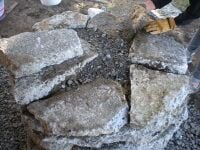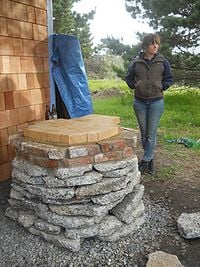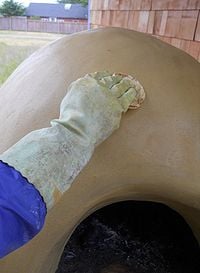"Earth turns to gold in the hands of the wise."-Rumi
"If we can't, as artists, improve on real life, we should put down our pencils and go bake bread." — Barbara Kingsolver
Basic Cobb Information[edit | edit source]
What is Cobb?[edit | edit source]
We walk on the Earth every day, however so many people do not realize that they are walking on an incredible valuable natural building material. Cobb is made from materials that we walk on each and every day; materials from the Earth. Cobb is a simple mixture made up of clay, sand, straw and water. When wet, cobb is an ideal material for molding and sculpting into any shape you desire. Mixed together in the right ratios, these natural materials dry and form into a very solid structure. Cobb is an extremely durable material, but will last longer in rainy climates and be more resistant to changing weather if a roof structure is built over it. Cobb is most often used to build ovens, benches, and even houses! (Cobb is Adaptable!)
Where is Cobb?[edit | edit source]
Cobb is found all over the world, all the way from England to Latin America, to the Southwest, and even here in Humboldt County. Cobb is an ancient building material that people have been using for centuries. In fact, the first oven ever built was made from cobb.[1] Many cobb structures, such as traditional cobb houses in England, built hundreds of years ago, still exist today.


Cobb Ovens[edit | edit source]
Cobb Ovens, often referred to as Earthen Ovens, have been used all over the World, for many years.
Cobb Ovens Contain Four Parts[edit | edit source]
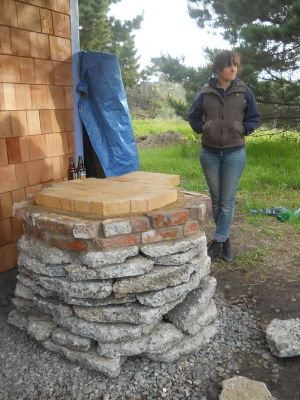



Foundation (Base)[edit | edit source]
Your foundation should aim to:
- Insulate Your Floor
- Protect against ground moisture
- Support the weight of your oven
- Keep the structure from sifting when the ground freezes or is wet
- Raise the foundation to desired working height
Dense Thermal Mass Layer[edit | edit source]
This is the most important layer of the oven.
This layer is made up of clay and sand, the ratio depends on your testing of materials, but you will usually use more sand than clay (We used a 2:1 ratio)
This layer acts as the "thermal mass" absorbing the heat of the fire and slowly radiating the heat, which cooks the food in your oven.
Insulation Layer[edit | edit source]
AKA Wooly Mammoth Layer
This is a four inch layer applied on top of the thermal mass layer.
The Insulative Layer is a mixture of clay slip (clay soaked in water) and straw, or sawdust.
This layer acts as insulation by keeping the heat radiated by the thermal mass layer trapped in the oven.
Outside Layer (Plaster Layer)[edit | edit source]
This layer serves to protect your oven from outside influences, and sustain your oven's life.
You have a variety of options for your final layer.
You can choose from many different kinds of plasters such as: mud, stucco (mixture of lime and sand), traditional African mixes of manure and clay, and even BLOOD!
Important: do your research and experiment with blood plaster before deciding to use it for your oven. We mixed goat's blood with a lime and wheat paste mixture and ended up with a spotted chicken pox oven, because tiny plasma pockets of blood exploded over night. We ended up covering this layer with a lime wash mixed with oxide for color, which solved this spotty problem. (See How To Construct Plaster Layer for more details and photos)
How Cobb Ovens Work?[edit | edit source]
Cobb ovens differ from your regular indoor oven because they do not use direct heat. When you cook in most Earthen Ovens, you first stoke a fire, until your oven is heated and then scoop out the coals. If the oven is constructed right, the heat will be trapped inside the oven. The first layer of the oven radiates the heat, the second layer aids the first layer by insulating it and keeping the heat in the oven instead of letting it radiate outwards, and the third layer of your oven provides your oven with tensile strength and overall stability.
Cooking in earthen ovens usually takes some experimentation to get right, because each oven is unique. Once you get to know your oven's personality you can become a master outside baker! Earthen ovens can reach very high temperatures; some cobb ovens can reach up to 700 degrees Fahrenheit, and cook food very fast.[2]
Cobb ovens are more efficient if you plan on using them to bake or dry many things, or if you are cooking for a big group. Many people choose to cook in their oven, and then when the temperature of their oven starts to decline use the oven to dry things that require less heat. Examples include drying fruit, flowers, herbs and wood to be used for your next fire.
| Components of Cobb | Component | Type of Strength | Problems Without | Analogy |
|---|---|---|---|---|
| clay | adhesive strength, glue, binding | falls apart | mortar | |
| sand | compressive, geometric | crack, breaks apart | bricks | |
| fiber | tensile, cohesive | breaks under torque | rebar |
Why Cook in a Cobb Oven?[edit | edit source]
Cobb Ovens are Less Expensive[edit | edit source]
Since most of your materials come from the Earth, building your cobb oven is less expensive than buying a manufactured propane or electric oven. You can use recycled materials for your oven, and often use locally harvested materials. You usually do not need to spend a lot of money on anything except your firebricks for your hearth floor.
Here is the link to our costs of the HBCSL Oven - HBCSL cobb oven#Costs.
We were very fortunate to have access to urbanite and rocks thanks to DANCO and were allowed endless access to clay thanks to CCAT who also donated many items to us, and offered valuable advice and guidance. We were also very fortunate to have access to used bricks and sand on site.
The firebricks were our main cost at $3.50 each, but we later found that if we had done more research we could have obtained them for a cheaper cost. Definitely take the time and do your research to find the best deal.
Gas is also a big factor to consider, if you are building your oven in a location that you need transportation to reach. We did a lot of driving to and from the site, and drove numerous times to the Samoa Recycling Center to pick up urbanite and rocks. We could have reduced our driving by using a big truck to haul the materials, instead of driving two smaller cars that required multiple trips. This is something to consider if you are building your oven at a site you have to transport yourself and materials to.
Cobb Ovens are Fun to Build[edit | edit source]


Natural Building usually tends to be more labor intensive than other more mainstream building techniques, however natural building also tends to be a lot more fun! Building a cobb oven is virtually accessible to everyone, as long as they have an able body for some intense physical labor, and the most important qualification of all, enthusiasm!
Building a cobb oven would be a wonderful educational project for an elementary class. The main technique for mixing cobb is to pour your ratio of sand and clay onto a tarp and mix it by stomping on it with your feet, rolling it into a "burrito" and then when it is all mixed in, forming it into balls. This process creates a very tactile experience that allows you to connect in an intimate way with the Earth and the material you will be using to build your oven. I think kids, and adults for that matter, would find this part of the oven building process to be the most enjoyable, I mean who doesn't like playing in the mud?
Working with cobb is also a very special experience because you get to feel the materials you are building with, with your hands, and your feet. You feel the sand and clay being mixed between your toes, and you get to run it through your fingers, stare at it, smell it, and form it into shape. You are able to experience "first hand" what each material feels like, and feel what function the materials you are using will serve in your oven.
Cobb Ovens Create Community![edit | edit source]
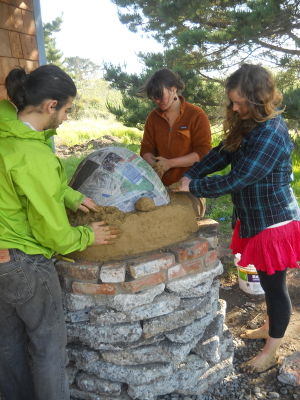
Building a cobb oven is easier, and a lot more fun, when you have many hands and feet to work together!
Building with cobb is accesible to everyone who has the physical capabilities, and a positive attitude to work hard, get dirty, and learn!
Once a cobb oven is fired, many loaves of bread, pizza, or whatever you are deciding to cook, can be made to feed lots of people on just one fire stoke.
Communities can come together to celebrate holidays, meetings, or other events and cook a delicious meal to be shared by all!
If you have your own personal cobb oven you can invite your friends over, and impress them with melt in your mouth wood fired pizza, or the best sourdough loaves they have ever tasted, baked fresh from your very own cobb oven! (This could be especially fun when the electricity goes out and all your friends with electric stoves are dying to cook a hot meal.)
A sense of empowerment and unity is created in the community, when everyone works hard together to create a beautiful and very useful cobb oven, that can be accessed by all.
Cobb Ovens Connect You to the Natural Elements of the Earth[edit | edit source]
Five things alone are necessary to the sustenance and the comfort of the dark ones {Indians] among the children of earth: The sun, who is the Father of all. The earth, who is the mother of men. The water who is the Grandfater. The fire who is the Grandmother. Our brothers and sisters the Corn and seeds of growing things….Who among men and the creatures could live without the Sun Father? For his light brings day, warms and gladdens the Earth Mother with rain which flows forth in the water we drink and that causes the flesh of the Earth Mother to yield abundantly seeds, while these-are they not cooked by the brand of fire which warms us in winter? –from Zuni Breadstuff
This Zuni story is a poetic way of advocating the value of building an Earthen Oven and cooking in it. Earthen Ovens can be a tool to ground oneself, connect with the Earth, and the elements of nature. When cooking in an indoor kitchen, it is very easy to get distracted with all the elements part of the hectic modern world, a phone ringing, a television blaring, a knock at the door. The demands and distraction of the modern world have turned many people away from the pure joys and pleasures of cooking. Now it is a rush to get dinner in the table, stuff the food in our mouths, and then go to bed and wake up early and do it all again the very next day. Barbara Kingsolver explains this very well in her book, Animal, Vegetable, Miracle: A Year of Food Life:
"When we traded homemaking for careers, we were implicitly promised economic independence and worldly influence. But a devil of a bargain it has turned out to be in terms of daily life. We gave up the aroma of warm bread rising, the measured pace of nurturing routines, the creative task of molding our families' tastes and zest for life; we received in exchange the minivan and the Lunchable."
Cobb ovens scream at you to slow down, without saying anything at all. Cobb ovens restore the beauty of food and the art of cooking, by restoring the connection of food and yourself to the elements: earth, water, air and fire. Cobb ovens require you to participate in the full process of cooking, you cannot just pull something out of the freezer, push a button, walk away, and then come back and stuff it in your mouth. When you are cooking in a cobb oven you are cooking outside, aware of the weather, the season, and the smells and feelings of nature.
Building Your Oven[edit | edit source]
Preparation[edit | edit source]
Design Plan[edit | edit source]
Take some time to brainstorm, and then design and draw out your plan for the oven. You have many options to consider in your design. Some things to consider are the height of your oven itself, and the height of your foundation. You can build your foundation as tall or as short as you want, according to what you consider to be a comfortable working and cooking height. Decide what you want to make your base out of, many common choices are bricks or urbanite, which is chunks of reclaimed concrete. Make a list of what materials you plan to use, what you desire your aesthetics to be, and decide whether or not you want to build a shelter over your oven.
Choose A Location[edit | edit source]
The first thing to consider is the location of your oven. If you live in a rainy, moist climate, like Humboldt County, you want to make sure to build somewhere you can construct a shelter structure over your oven. You can build the roof after you finish your oven, but you want to build the shelter quickly so your oven will dry, and not deteriate quickly due to weather. Fire and safety issues should be considered, and you want to make sure you build your oven far enough away from a building, and have proper ventilation. It is convenient to build your oven close to where you will prepare your food to be cooked in the oven, many people choose to build a prep station, with a table, cutting board, and cooking tools right next to their oven. (Something we are hoping will be incorporated into our cobb oven at HBCSL Eco-Hostel in Manila)
Another very important element to consider is the location of your door. Figure out which way the wind blows, and make sure the opening of your oven is facing the opposite direction of the wind. Finally consider the surface of the ground you are building on. You want a flat, leveled space, and may want to lay down a layer of small crushed up rocks, to add another protective layer between your oven and the ground.
Gather Materials[edit | edit source]
You will need:
- Sifted Clay (sifting frees the clay of organic materials you do not want to be part of your oven)
- Builders or Mason Sand (can be found at most hardware/building supply stores)
- River Sand
- Beach Sand (or whatever sand is most convenient to your site)
- Water
- Straw (Important to get straw and not hay, hay has more nutrients than straw and will sprout!)
- Crushed up Rocks or Gravel
- Wood shavings or sawdust
- Firebricks for your hearth floor (How many depends on the size of your oven)
- Regular Bricks for constructing the base
- Urbanite (if you choose to use it for your base)
- Recycled, empty glass bottles (optional for extra insulation)
- Newspaper (You can also use leaves or a plastic bag, we found newspaper to be the best choice because it stuck easier than leaves and did not have the chemicals a plastic bag contains)
- Hydrated S lime
- Cat-tails (the plant not the animal!)
- Wheat paste
- (recipe can be found at: (https://www.appropedia.org/CCAT_Natural_Exterior_Wall_Plaster_and_Paint,_Appendix#Wheat-Paste)
- Wood for Creating Fires in your oven
- Fuel (matches, lighter, flint) to start your fires
- A shovel or two
- A rake
- A few screens for sifting clay and sand
- 5 gallon plastic buckets (for mixing and transporting materials)
- Wheelbarrow (very helpful but not required)
- Tarps (for mixing cobb, and protecting your oven from the weather if not covered by shelter)
- Tape measure
- Pencil
- Twine or string (to tie to pencil to create a circle)
- Knife
- Rubber gloves (for handling lime)
- Face mask and goggles (for mixing lime)
- Basic carpentary tools: saw, hammer, drill, fastners, screws, nails etc (not appropriate for every design)
- Sculpting tools if you incorporate sculpture design
- Decorations (ex: bones, shells, skulls, sea glass) if desired
- Oxide (to add color to your oven)
- A few yogurt cups (for smoothing out the plaster layer)
- Basic Carpentry Tools: hammer, nails, drill
- Closed Toes Boots for moving heavy materials (urbanite)
- A willingness to get DIRTY
Construction[edit | edit source]
Foundation (Base)[edit | edit source]
We built our oven four inches away from the shed structure at the HBCSL Eco-Hostel. A four feet roof extension was built over our oven to protect our oven from the elements of the unpredictable Humboldt County weather. We are hoping that the roof will be built out a bit farther to fully protect our oven, or at least a gutter to give our oven four more inches of protection. The wind can be a huge factor in Manila, ripping up over the dunes, and so we planned for our door to be facing southwest, the direction with the least amount of wind.
Before we began building our base, we spent about an hour ridding our chosen site of various forms of garbage that were scattered throughout the site. We turned the soil with two shovels and a rake and created a leveled surface, about 6 by 6 feet, to give us plenty of room to build our oven. We then laid down 3 inches of small rocks we found in a pile around 6th Street in Arcata. We laid down the rocks and leveled them out by pressing them down with large chunks of urbanite (free) that we also harvested from the Samoa Recycling Center.
Sand Dome[edit | edit source]
IMPORTANT: Make sure that you allow enough time to make your sand dome and then cover it with your thermal mass layer, immediately after finishing your dome. If you don't a "cold joint" in your first layer might cause cracking.
Thermal Mass Dense Layer[edit | edit source]
Preperation[edit | edit source]
The first step for making this layer is mixing together your sand and clay ratios. If you are building your oven with a group of people, it can be a good idea to split the group up into teams with one team forming the sand dome, while the other team mixes the cobb.
Mixing Cobb[edit | edit source]
First pour your sand and clay ratios onto a tarp.


Now it is time to mix. This can be done alone but music and friends make this part of the project an experience you will never forget!
Pour the sand and clay onto the middle of the tarp and jump right in!
I recommend using your bare feet to mix, however if you are worried about glass or other sharp materials possibly being in your mixture, you can wear boots, but you loose the tactile experience. Make sure to stay on the tarp when you are mixing. This allows you to not get any organic materials on your feet that you would not want in your oven layer.
Stomp, twist, jump, dance. The possibilities are endless, just use your feet to mix the materials together.
"Burrito" your mix often. This is done by picking up the ends of one side of your tarp and rolling the mixture into a burrito and then jumping right in again.
Repeat this process, until you feel your materials are mixed together well and then conduct a drop test.
Drop Test[edit | edit source]
For our thermal mass layer we mixed batches of river sand and clay at a 2:1 ratio and added water until each particle of sand was thoroughly covered with clay. We knew the mix was ready after performing a "drop test" several times. For this test we took a fist full of the material and molded it into a packed ball, held it up at shoulder height and dropped it to the ground below. If it went flat and "pancaked" we knew there was too much water and so we continued to mix, adding more sand sparingly. We were looking for the ball to hold together, smooshing out only halfway or so.
Constructing Thermal Mass Layer[edit | edit source]
Once we reached the consistency we were looking for we made balls of the cobb we had mixed together and started building our first layer. This layer should be a uniform 4 inches thick.
Insulation Layer[edit | edit source]
Aka "woolly mammoth layer." This layer consists of straw, clay and water.
| Image | Step |
|---|---|

|
Step 1: We made a "soupy" clay slip by mixing sifted clay in water and dunking handfuls of straw into this mixture.
It is important to make sure the straw is thoroughly coated with your clay and water mixture. |
| File:Insulative Layer aka wooly mammoth layer.JPG | Step 2: We then packed this mixture lightly on top of our thermal mass layer, again starting at the base and working up, building a 2 inch layer.
It is important to not compress the straw too much because the straw has the ability to hold the structure and air which allows it to function as the insulative layer. |

|
Step 3: After this layer had firmed we measured our door and cut a hole and excavated the sand that we had used to build the sand dome. We then let this layer dry for about a week. |
Plaster Layer[edit | edit source]
We decided to use a lime plaster for our final layer of the oven, to help protect our oven from the rainy and moist climate of Humboldt County.
IMPORTANT: Lime is caustic so be sure to wear protective gloves, eye and mouth covering.
We used a recipe from a natural plaster Appropedia page as an outline [[[CCAT Natural Exterior Wall Plaster and Paint, Appendix]] and then made the following substitutions: 12 cups mortar clay + 12 cups lime-putty + 20 cups fine sifted sand + 12 cups cat tails + 2 cups wheat-paste = 48 cups plaster / 16 = 3gal plaster total.
Lime Wash[edit | edit source]
We decided to add a lime wash so we could add a more asthetically pleasing color to our oven, and add another thin layer of protection. We let our plaster sit for 48 hours and then went over it with a lime wash. Our lime wash consisted of slacked lime, yellow oxide, black copper oxide, and water.
Finished Product[edit | edit source]
Our beautiful cobb oven at the HBCSL Eco-Hostel in Manila California.
Testing[edit | edit source]
TBA we are in the process of waiting for our oven to dry completely before we conduct any testing.
The best way to learn about your oven is testing it, which an also be a very fun and knowledge gaining experience. Small, dense wood is best for starting fires in your oven, but you can use whatever you have available to you. It is very important to use dry "fuel" for your oven. If the wood you are using is wet, it will produce steam and cool and stall the fire. However your oven can also act as a kiln, driving out 50-75% of the moisture in your fuel. It is a good idea to use thin wood because it gives the fire more surface area to burn. Burn your fuel in small loads of fast hot fires, aiming to heat the whole floor of your oven. A great way to reduce fuel consumption and heat your oven quicker, is drying the wood you will use for your next fire when the oven has cooled below 250 degrees.
Air Test: It is important for the air to be able to flow freely to the back of your oven. Do not cram the oven full with a big fire, it tends to burn slowly and produce lots of smoke, which means your oven is choking. If this happens try to figure out what is blocking your air floor, like small sticks or coals and remove them. Try to get flames at the far end of your oven. The best way to achieve this is by starting your fire in the front and then slowly pushing it back, adding new fuel to keep it burning.
More Tests: Record the inside and outside temperatures of your oven over time, record the amount of wood you put in, and ash scooped out, the amount of food you cooked and amount of time you cooked.
Update: The first round of testing was conducted at the site on Thursday May 12th. I think the biggest factors were the high wind, cold outside temperature, and the lack of dry wood. Keeping the fire burning proved to be quite the difficult task. It was very hard to find dry wood in Manila's moist climate, (this could be solved by creating a wood storage area under the shelter.) We burned small fires to the best of our ability over a two hour period, slowly pushing the fire back and adding more fuel. We did not have a scale with us but estimated that we put in about three punds of wood over a two hour period and scooped out about a pound of ash in the end. There were only two of us and a small food budget so we just brought english muffins, cheese and avacodo to cook sandwhiches. We put them in for about six minutes and they melted and cooked little bit, but not as much as we had hoped.
We began testing at 7:00 P.M. the outside temperature was 55 degrees F and our oven's temperature was 55 degrees F. 7:15 outside: 54 F inside: 70 degree F 7:30 outside: 54 F inside: 80 degree F 7:45 outside: 53 F inside: 88 F 8:00 outside: 52 F inside: 100 F 8:15 outside: 50 F inside: 111 F 8:30 outside: 50F inside: 126 F 8:45 outside: 50F inside: 140 F 9:00 outside; 50F inside: 155 F
Note: I think it would be more accurate to conduct testing on a sunny day, when lots of dry wood is available. it would also help to get a lot of people out to the site so we could cook a lot of food and produce more accurate results.
Concerns[edit | edit source]
I believe the best way to learn is by doing and we learned some very valuable lessons when we were constructing our cobb oven.
One lesson was to not add too much water to our clay and sand mixture for our thermal mass layer, or else it will slump! We did not realize our clay had so much water in it, and when we began building our thermal mass layer it began to slump. We tried to stop the slumping by stacking bricks next to the layer to keep it propped up, but nothing worked, it was too WET. We decided to call it quits for the day and then came back the next day and realized that we were not going to be able to use this mixture for our first layer, so we took it off and mixed it back in with more sand and clay. Although this was a disappointment to us at first, it was a great learning experience. We realized that we have to be very careful about the amount of water we add, and the amount of water the clay contains, and we also realized we needed to refine our drop test.
We also learned that blood may not be the best way to add color to a cobb oven, because it ended up splattering all over our oven. Maybe with more research you could successfully use blood to color your oven, but we found that oxide (which you can find in most ceramic supply stores) worked really well.
Finally we learned that building a cobb oven is a lot of fun, but also a lot of work, and we always seemed to underestimate the amount of time to to get things done. Sifting clay was an especially long process, taking us about an hour each to fill up a five gallon bucket. I think that the more people you have to build a cobb oven with the better. More hands and feet means things get done a lot faster and can also make the building process a lot more fun.
Thanks[edit | edit source]
Special thanks to Lonny Grafman for inspiration, patience and guidance and for teaching such a valuable class!
Thanks to Sean Armstrong for guidance, support, big smiles, and the willingness to lend a hand and some bones!
Thanks to Humboldt Bay Center For Sustainable Living for having the faith in us to build a cobb oven at your eco-hostel.
Thanks to Eric Recchia & Aaron Gallo for lending a hand at the site and thanks to Greg Pfotenhauer, Andrea and everyone else who helped sift clay, we appreciate it so much!
Thanks to CCAT for allowing us to dig up your clay, donating us materials, and offering us countless valuable advice.

